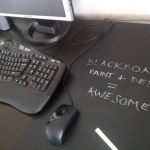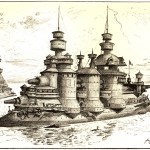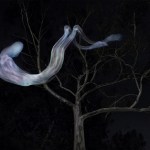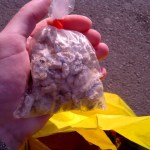As part of my job I occasionally get emails from young people (well, younger than me) who want to know this or that about science communication. I don't know why they ask me, I feel I know about as much about the subject as they do, but that's the way it is. (They also ask for career advice, which I'm even less qualified to answer.)
So this guy has an essay he's writing, on the role of the science journalist in the 21st century, and his opening question stops me dead:
Why do you think it's important to have good public communicators of science?
The more I thought about it, the…

Long held to be the window to the soul, research published today in PLoS shows that the eyes are not the tell-tale Achilles heel of liars, despite what as NLP practitioners, Hollywood and innumerable armchair mentalists would have you believe. Snip:
For decades many NLP practitioners have claimed that when a person looks up to their right they are likely to be lying, whilst a glance up to their left is indicative of telling the truth.
Professor Richard Wiseman (University of Hertfordshire, UK) and Dr Caroline Watt (University of Edinburgh, UK) tested this idea by filming volunteers as they…
This three-story-tall mural was painted by international artist Josef Kristofoletti on the side of the ATLAS control room directly above the detector:
This project was inspired by the same questions that physicists are trying to answer; where did we come from, what does it mean to be human, and what is our place in the universe? The artist worked closely with physicists at CERN over the course of a year to create the mural. It depicts the artist's interpretation of what the Higgs boson might look like.
This short, time-lapse video was finished June 2012, using photos that were taken…
All That I Am is an art piece which involves a transgenic mouse imbued with the essence of Elvis Presley in an effort to model the late great's behaviour.
Koby says:
A combination of three online services make this project possible. Hair samples of Elvis Presley, bought on ebay were sent to a gene sequencing lab to identify different behavioural traits (varied from sociability, athletic performance to obesity and addiction).
Using this information, transgenic mice clones with parallel traits were produced.
The genetically cloned models of Elvis are tested in a collection…
The BBC reports that for the first time, scientists have been able to watch the an infection develop in real time, inside an animal. The best part? They used a special glowing bacteria and measured the rays of light escaping from the animal's body:
The researchers used a genetically modified version of a mouse bug, Citrobacter rodentium, which produces light.
Dr James Collins, who works in Prof Frankel's lab, then puts the infected mice inside the scanner.
"It is a dark box which keeps the animals warm and blocks any other light from coming in. It has a camera at the top so we can very…
My desk was a bit too shiny for my optical mouse to work properly, so I needed to coat the surface in a matte paint. What better than blackboard paint?
Those of you who follow me on Twitter will probably remember that around the time Scienceblogs shifted to a new format, I was busy doing a final piece of development on my old website, SciencePunk.com. I felt it had sat in stasis for too long, and I’d outgrown a lot of the views and content on there. I wanted to paint something fresh onto it, but that required a blank canvas. Rather than delete everything (which seemed like quite a blunt act), I thought it would be more fun to visualise the neglect that it was suffering.
So, with the help of Steve Moss, I had a plugin that would…
Yet another well-meaning yet soul-crushingly misdirected initiative from the public purse, this time as the European Commission engages in a cack-handed attempt to convince the high-heeled, lipstick stained people they've conflated with women in general that science is a Girl Thing. It seems to assume that it's impossible for women to be interested in chemistry unless it's in the context of cosmetics, or biology except insomuch as fashion. If you can stomach it, here's a the video in all its garish horror - Science: It's a girl thing (now removed in shame by the makers -…
Albert Robida was a French illustrator and author who produced a series of fantastical drawings to accompany three futurist novels he wrote in the 1880s. Often caricatured as derivative to Jules Verne's science fiction, the two are more fairly seen as contemporaries. Whereas Verne's adventures took place in the proximity of scientists and engineers, Robida built his technological marvels into everyday life, and studied the effects they would have on the public at large. La Vie Électrique includes a wonderfully French take on everything from videophones, flying…
In the latest issue of Significance, the journal of the Royal Statistical Society & American Statistical Association, economists Barry Reilly, Neil Rickman and Robert Witt take a look at the surprisingly mediocre returns that bank robbers can expect. The Fiscal Times has the story:
In the U.S., based on 2006 data, the average take from a bank heist was $4,330. In the U.K., it was much bigger: £20,331, based on 2007 data (or about $40,000 based on the exchange rates that year). A third of the robberies yielded nothing, meaning that the average take from a successful…
So I unexpectedly got a ticket to see the screening of Ridley Scott's Prometheus on Wednesday. I think it's because I was nice to Fox and ran that competition for Tim Burton's 9 that one time where people won sweet ass picture encyclopaedias. That was fun. Anyway. Here's my review of Prometheus with a look at the science behind it. There will be spoilers. So if you want to go into the movie knowing nothing, and yet insist on reading this blogpost first, you're going to have a bad time.
Anyway, the science. The basic premise of Prometheus is that humans…
In 1993, convicted murderer Joseph Jernigan was executed in texas and his body donated to science. It was preserved in gelatin and sliced into 1,871 sections. Scans of these sections were strung together into an animation, and played back on a computer screen as it was swept across the field of a long-exposure camera shot. The result is these strange and haunting images of Jernigan's ghost, floating in the twilight. More images can be found here, created by Croix Gagnon and Frank Schott.
Via Mo Costandi
(A rant hammered out in bed. Not spellchecked, fact checked, or cross checked.)
So a few weeks ago the world swooned over the latest exciting tech announcement from Google, Project Glass. But I have mixed feelings, which in my time-honored style I am only just now getting down on paper. I watched the video, and I sat there and thought: really? Is that it?
It's perplexing to me that a technology that holds as much potential as Project Glass does should be introduced as nothing more than a glorified smartphone interface welded in front of your face, as if there was some pressing need to furnish…
So here's a modest proposal for film rental / streaming companies like LoveFilm and Netflix: why don't you have shareable playlists like Spotify?
You see, I was reading Time Out's 100 Best Horror Films and I thought, there must be loads of these lists out there, on all kinds of criteria, for all kinds of audiences. Why isn't there a button at the end labelled "ADD THESE TO MY LOVEFILM"? There are buttons to tweet it, Like it, add it to Reddit, Dig, and a dozen other aggregation sites, but none that actually serves the purpose of the list: getting these films in front of my eyes!
I don't…
Portland artist Eric Franklin spent over 1,000 hours sweating over hot glass and noble gasses to produce Embodiment, a glass skeleton filled with glowing krypton.
Speaking about the process, Eric says:
Every glass seal has to be perfect, and this piece contains hundreds. Everywhere one tube joins another, or a tube terminates, glass tubes were sealed together. They have to be perfect in order to preserve the luminosity of the krypton. If one rogue molecule gets inside the void of the glass tubing it can eventually contaminate the gas and it will no longer glow. There are times when the…
There is only one truly kosher sport when it comes to the Olympics: athletics. All those ancient Greeks did was run around in the dirt butt naked. It took over fifty years for them to add a second sport: more running, but in a wild twist, a race over twice the distance as before. Over the years more sports were added, including one involving running in full armour, which much have provided much-needed advertising canvas for Classical games sponsors.
After the revival of the games in 1894, various sports have been added, some successfully, whilst others fell by the wayside. Take a tour…
A cross posting from my Posterous space - a short imagining some implications of lab-grown meat.
He was a huge man, thick forearms dotted with burns and pale scars. He spoke in a dull monotone about the unique difficulties in preparing synthetic meat. Roscoe wondered how much he weighed, and tried to calculate how much that would be worth when sold in Longpig wrappers. As he spoke, Roscoe noticed the chef was absent-mindedly palpating his own arm, as if feeling for the texture of the meat under his skin.
Read Transubstantiation
Dear scientists,
Why do you study, the thing that you study? What is it, and why did you choose to study it over all the other possible things you could have studied?
Best
Frank
Toward the end of last year, being in possession of two novelties - a girlfriend and a steady job - I decided to spend my free evenings crafting a very special piece of jewellery. I was inspired by a visit to Barometer World in the late summer, where I discovered the curious material known as storm glass (tragic backstory recounted here).
In short, a storm glass is a weather divination tool so old that nobody really knows where they came from. It's likely they were borne out of alchemy experiments performed during the medieval period. Inside a sealed glass tube, crystals bloom, wither and…
This weekend I visited the Trauma exhibition at London's GV Art gallery. The pieces all relate in some way to physical and psychological trauma inflicted on the body, by a range of artists working alone and in collaboration with medics.
Some of the items are underwhelming verging on irritating - placing histological slides on a plinth does a disservice both to art (because there is no emotional narrative contained within) and to science, because it implies that the inherent wonder and beauty of science is absent unless it is repackaged as a gallery exhibit. (Hello? Museums present objects…











